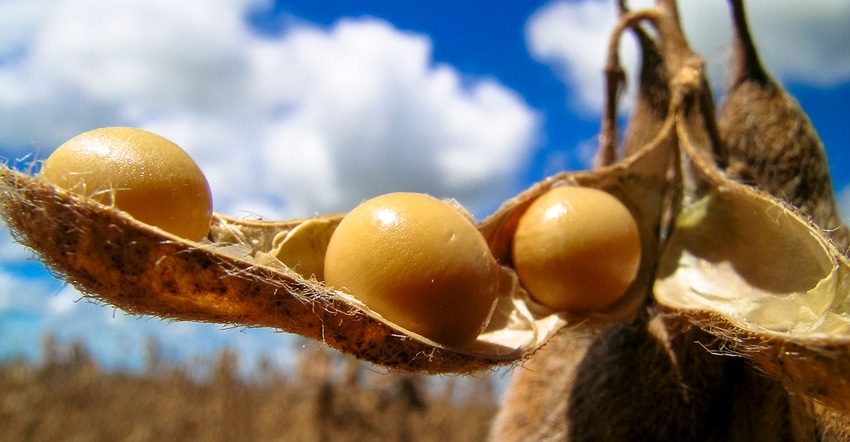
A 111-bushel soybean yield might sound impressive, but it wasn’t something Mike Shearer was necessarily shooting for.
Yes, he did some things different in his 1.7-acre soybean yield contest plot, but he gives most of the credit to Mother Nature.
“We really didn’t do anything special,” he says. “We did some fungicide and insecticide when it was starting to pod. It’s more just the weather, getting rain.”
Shearer was the overall winner of the 2019 Pennsylvania Soybean Contest. Shearer farms 400 acres — 35 owned — with his family in Mount Joy.
He planted soybeans April 23 — about the same time he planted corn — in 15-inch row spacing at a 150,000-seed population. Pioneer 31T77 was planted using a no-till corn planter. The plot was harvested Sept. 24.
Getting seed in the ground early and using a solid short-season variety were important to getting good yields, he says, even in the rest of his full-season soybean fields — 44 acres. He averaged 94 bushels an acre on the farm.
His multiyear crop rotation starts with corn, then full-season soybeans, winter wheat, double-crop soybeans and then back to corn.
Shearer and his family also do custom planting and harvesting for other farmers in the area. He says most other fields where soybeans were planted in late April also saw yields of 90 bushels or higher. “After that they started to taper off,” he says.
 CREDIT TO WEATHER: Mike Shearer, a farmer in Mt. Joy, Pa., says he applied fungicide and insecticide right around pod fill, but he credits mostly good weather for his 111-bushel soybean yield.
CREDIT TO WEATHER: Mike Shearer, a farmer in Mt. Joy, Pa., says he applied fungicide and insecticide right around pod fill, but he credits mostly good weather for his 111-bushel soybean yield.

While he downplays the effects he had on his yields, it seems like the fungicide application he made in mid-July — during a wet period and right when the pods were forming — made a difference. Did it pay? Shearer estimates a yield payoff of between 5 and 10 bushels in places where extra fungicide was applied.
“You could visually see a difference when we were combining,” he says.
Early planting, big yields
Richard Burd planted most of his more than 500 acres of soybeans in late June, but he’s been experimenting with early planting to get ahead of wet weather the past couple of years.
He normally doesn’t use a drill — he usually opts to plant his soybeans using a no-till corn planter — but he drilled 16 acres of soybeans in 7.5-inch rows April 4.
Two treatments of fungicide early in the season led to good growth. He averaged 87.58 bushels in the contest plot, but he credits much of his success to getting in the fields early. He harvested Oct. 4.
“My goodness, I never saw so many pods on soybeans plants,” Burd says. “One spot in the field that the monitor read said 123. No freeze or anything.”
By comparison, his regular soybean fields, which were planted June 12, only averaged 31 bushels an acre. Deer damage was heavy in those fields, too.
Burd says he’ll probably plant a quarter of his soybean acres early next year. He trying to find the ideal system for his farm.
More entrants, bigger yields
Yields across the contest averaged 4 bushels higher than in 2018, according to Andrew Frankenfield, Penn State Extension educator.
This year’s mean yield was 83 bushels an acre, up from 79 bushels last year. Sixty farmers entered this year’s contest and 37 farmers sent back results, up from the previous year’s 25 plot results.
Four entries had yields over 110 bushels an acre, Frankenfield says. Another 5% reported yields between 100 and 110 bushels; 24% reported yields between 90 and 100 bushels; and 32% reported yields between 80 and 90 bushels.
Eighteen soybean varieties from Asgrow, Channel, HiSoy, Hubner, NK and Pioneer were evaluated.
“The yield-limiting factors in 2019: wet spring and early summer followed by a dry, late summer. This delayed some plantings and stressed those plantings that were established early,” he says. “The late dry spell hurt pod fill on later plantings. 2019 harvest conditions were good in September and early October; 59% of the entries were harvested by Oct. 10 and they averaged 90 bushels an acre.”
Regional winners
Central. Jay Arentz of Littletown, 91.31 bushels, Pioneer 34A13X.
Northern. Raymond Martin of Wellsboro, 64.31 bushels, Pioneer P31T77R.
Western. Richard Burd of Uniontown, 87.58 bushels, Pioneer 34A13X.
Click the link below to see the full results.
About the Author(s)
You May Also Like






